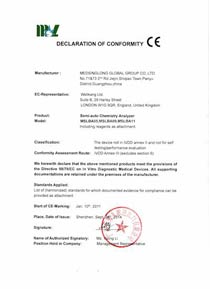Point-of-care testing (POCT), or bedside testing is defined as medical diagnostic testing at or near the point of care—that is, at the time and place of patient care.[1] This contrasts with the historical pattern in which testing was wholly or mostly confined to the medical laboratory, which entailed sending off specimens away from the point of care and then waiting hours or days to learn the results, during which time care must continue without the desired information.
Point-of-care tests are simple medical tests that can be performed at the bedside. In many cases the simplicity was not achievable until technology developed not only to make a test possible at all but then also to mask its complexity. For example, various kinds of urine test strips have been available for decades, but portable ultrasonography did not reach the stage of being advanced, affordable, and widespread until the 2000s and 2010s. Today portable US is often viewed as a "simple" test, but there was nothing simple about it until the more complex technology was available. Similarly, pulse oximetry can test arterial oxygen saturation in a quick, simple, noninvasive, affordable way today, but in earlier eras this required an intraarterial needle puncture and a laboratory test; and rapid diagnostic tests such as malaria antigen detection tests rely on a state of the art in immunology that did not exist until recent decades. Thus, over decades, testing continues to move toward the point of care more than it formerly had been. A recent survey in five countries (Australia, Belgium, the Netherlands, the UK and the US) indicates that general practitioners / family doctors would like to use more POCTs.
The driving notion behind POCT is to bring the test conveniently and immediately to the patient. This increases the likelihood that the patient, physician, and care team will receive the results quicker, which allows for better immediate clinical management decisions to be made. POCT includes: blood glucose testing, blood gas and electrolytes analysis, rapid coagulation testing (PT/INR, Alere, Microvisk Ltd), rapid cardiac markers diagnostics (TRIAGE, Alere), drugs of abuse screening, urine strips testing, pregnancy testing, fecal occult blood analysis, food pathogens screening, hemoglobin diagnostics (HemoCue), infectious disease testing and cholesterol screening.
POCT is often accomplished through the use of transportable, portable, and handheld instruments (e.g., blood glucose meter, nerve conduction study device) and test kits (e.g., CRP, HBA1C, Homocystein, HIV salivary assay, etc.). Small bench analyzers or fixed equipment can also be used when a handheld device is not available—the goal is to collect the specimen and obtain the results in a very short period of time at or near the location of the patient so that the treatment plan can be adjusted as necessary before the patient leaves. Cheaper, faster, and smarter POCT devices have increased the use of POCT approaches by making it cost-effective for many diseases, such as diabetes, carpal tunnel syndrome (CTS) and acute coronary syndrome. Additionally, it is very desirable to measure various analytes simultaneously in the same specimen, allowing a rapid, low-cost, and reliable quantification. Therefore, multiplexed point-of-care testing (xPOCT) has become more important for medical diagnostics in the last decade.




 Price is 8-20% Lower Than Other
Price is 8-20% Lower Than Other










